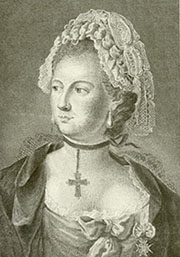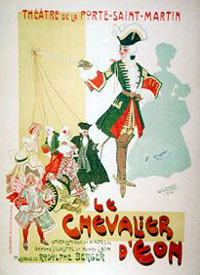Spy in a Skirt
 A brief exhibition and conference is now taking place in Leeds on one of the most intriguing characters of 18th century society in England and France, the Chevalier d’Eon, who no one appeared to know whether was a man or woman. The Chevalier, a native of Burgundy, had been posted to London in 1763 by the French diplomatic service and for most of the next half a century was celebrated as a person of truly indeterminate gender. In that bawdy era, such was the fascination that a betting book was opened at the London Stock Exchange with the latest odds posted in the coffee houses. Only at d’Eon’s death was the secret revealed.
A brief exhibition and conference is now taking place in Leeds on one of the most intriguing characters of 18th century society in England and France, the Chevalier d’Eon, who no one appeared to know whether was a man or woman. The Chevalier, a native of Burgundy, had been posted to London in 1763 by the French diplomatic service and for most of the next half a century was celebrated as a person of truly indeterminate gender. In that bawdy era, such was the fascination that a betting book was opened at the London Stock Exchange with the latest odds posted in the coffee houses. Only at d’Eon’s death was the secret revealed.
What made this more than a story of mere titillation was the world of smoke and mirrors that d’Eon inhabited.
Born in 1728 and baptised as a boy named Charles-GeneviËve-Louis-Auguste-AndrÈ-TimothÈe Eon de Beaumont, he excelled at languages and graduated in law from the CollËge Mazarin in Paris. By 1756, he was inducted into Louis XV’s espionage network, the Secret du Roi.
D’Eon had already proved himself able to pass as a striking looking woman by an appearance he made at a masked ball. This prompted Louis to post him to the Moscow court of Empress Elizabeth I, not as a man but as a woman. If this seems odd to us now, at that time the European upper classes were fascinated by the idea of cross-dressing, particularly for society events, and d’Eon appeared more adept at this than most. Enough to pass as a Mademoiselle Lia de Beaumont and to create a sensation at the cross-dressing salon that Elizabeth held every Thursday. All this was not just whimsy on the part of Louis XV. At that time there had been a diplomatic crisis between Russia and France, and it seems as if d’Eon’s spying and maneuvering helped to restore full relations between the two countries.
Back in France in 1761, d’Eon was assigned to another mission, this time to go to London and see if the British would be prepared to sign peace agreements and also to size up the prospects for a possible French invasion. He dressed initially as a man and hoped for promotion to the position of French ambassador. Assuming his stay would be a long one he used his Burgundy contacts to start importing wine for the English elite. But his plans fell apart when he was passed over for the ambassador posting and he found himself in debt with the wine business.
Refusing demotion and recall to France, d’Eon threatened to reveal Louis XV’s invasion plans. Amidst all this intrigue, around 1770 rumours began to circulate that d’Eon was a woman, possibly initiated by d’Eon himself who would have reasoned that French agents would have been less likely to kill a woman. He slipped easily into female clothing and his genderbending became the talk of London society.
 ” alt=”historical shemales” align=”left” />This transition is being discussed at the d’Eon conference in Leeds, which is being organised by Dr Simon Burrows, a senior lecturer in Modern European History at Leeds University. He is the author of a forthcoming biography on d’Eon, and will argue that d’Eon’s less admirable qualities should not be discounted, either. “His actions were also connected to his craving for publicity. We can’t ignore that he was also a dubious figure who fabricated stories against his enemies,” he says. The d’Eon exhibition is being held in the Brotherton Library, which has a large collection of d’Eon’s private papers and which is part of Leeds University Library.
” alt=”historical shemales” align=”left” />This transition is being discussed at the d’Eon conference in Leeds, which is being organised by Dr Simon Burrows, a senior lecturer in Modern European History at Leeds University. He is the author of a forthcoming biography on d’Eon, and will argue that d’Eon’s less admirable qualities should not be discounted, either. “His actions were also connected to his craving for publicity. We can’t ignore that he was also a dubious figure who fabricated stories against his enemies,” he says. The d’Eon exhibition is being held in the Brotherton Library, which has a large collection of d’Eon’s private papers and which is part of Leeds University Library.
Another speaker, Gary Kates, author of Monsieur d’Eon is a Woman, believes d’Eon needed to become a heroic female to “regenerate his soul”. Another d’ Eon authority, Clare Harman, says it was only the psyche of a woman, not the clothes that he craved. D’Eon wanted “to be considered a woman who passed herself off successfully as a man [rather than] to dress per se as a woman”, she says.
Whatever d’Eon’s deepest motives, he became far more famous than he would have had he become French ambassador. He was caricatured in the broadsheets of the day, there was a play named The Female Chevalier, and a financier offered d’Eon £30,000 to disrobe. He wisely refused, and the mystery grew around him.
By now, France had a new king, Louis XVI, who agreed to pay off d’Eon’s debts on the proviso that he return to France and continue dressing as a woman. D’Eon had earned his Chevalier title as a captain in the French Dragoons and his masculine persona stirred on his return to France. He wore the plainest female clothing for a while, and then reverted to wearing his Dragoons’ uniform in his native Burgundy. For this he was imprisoned: a woman dressing as a man was considered indecent under French law at that time. With his father dead, only his mother knew the truth – and she seems to have kept very quiet.
D’Eon himself wrote that “I am humiliated and depraved among men; I am elevated and exalted among women.” He returned to England and resumed his feminine persona. He became a public performer, fencing in skirts for money, on one occasion taking on the Prince of Wales.
He was an object of curiosity amongst the most serious minded people. British prime minister Horace Walpole said “she” was a “noisy and vulgar individual whose hands and arms… are fitter to carry a chair than a fan”. Dr Johnson’s biographer James Boswell observed, “she seemed to me to be a man in woman’s clothes”. Mary Wollstonecraft considered d’Eon to be one of the pioneers of the feminist movement, articulating views about the female perspective from a unique position. D’Eon muddied the waters by saying, “God created man and woman, the one for doing good, the other for doing bad. So long as a man is a man, the earth is his; so long as a woman is a woman, virtue is hers.”
The Chevalier d’Eon died in a London apartment at the age of 81. A post mortem was held and the doctor, accompanied by 12 witnesses, recorded: “the male organs in every respect perfectly formed”. But as to whether Monsieur d’Eon found life enriched by crossing the gender divide, or whether he found himself occupying a no-man’s and no-woman’s land, is not really known. The conference is aiming to come to some conclusions on this.
Documentary evidence does however indicate that d’Eon died a virgin.
Posted: April 20th, 2006 under General.
Comments: none















 Ladyboys, as anyone who has spent any time with them will know, tend to exist in a different time zone to the rest of us.
Ladyboys, as anyone who has spent any time with them will know, tend to exist in a different time zone to the rest of us.